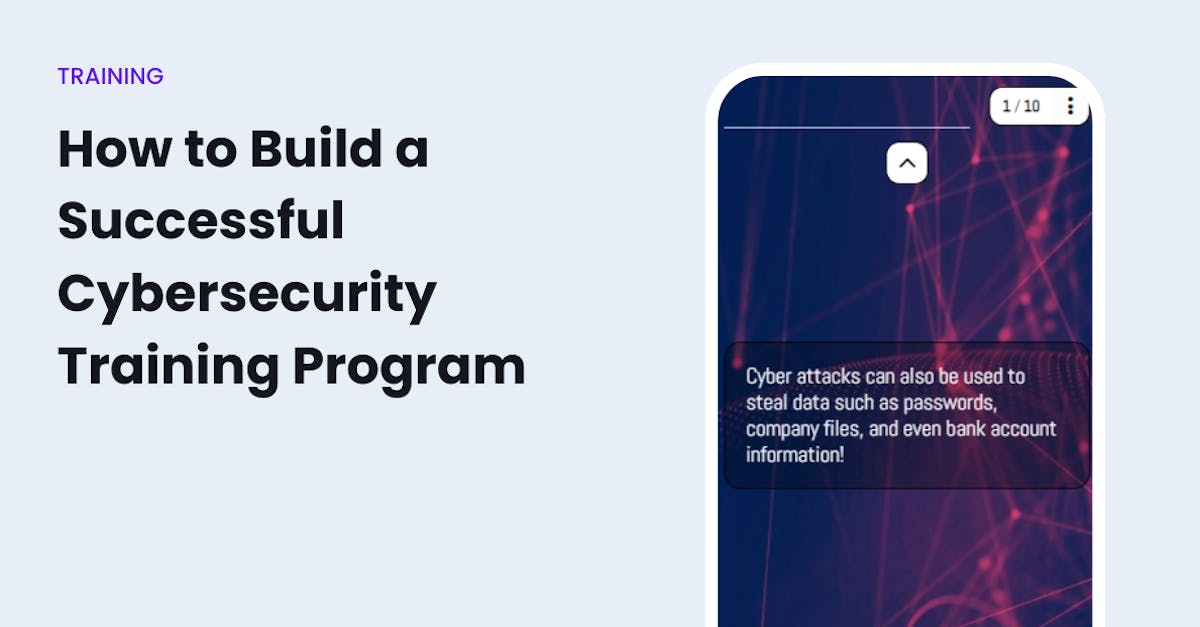How to build a successful cybersecurity training program

You can create a cybersecurity training program, but whether it has the desired effect is another matter. Too many times, companies handle cybersecurity training like a to-do list and wonder why it didn’t yield positive results.
Gathering employees in a conference room during working hours for a one-hour lecture on cybersecurity won’t achieve anything. Half will worry about their unfinished tasks, and the other half will likely zone out during all of it.
The problem isn’t the subject itself but how it’s being delivered. In this article, you’ll learn how to create an effective cybersecurity training program for your team. As a result, they’ll be equipped to identify and protect themselves and the company from potential cyber threats.
What is a cybersecurity training program and why is it important?
A cybersecurity training program is a proactive approach organizations use to educate their employees about the importance of cybersecurity and cybersecurity assessment. They learn to identify threats like cyber attacks, data hacks, and phishing activities. This training also teaches them the proper protocol for reporting potential breaches.

The importance of cybersecurity training can’t be overemphasized. According to new reports, 68% of organizations were victims of cyberattacks in the last 12 months.
When employees don’t understand the risk associated with cyberspace or their roles in protecting systems and data, they become vulnerable to attacks. This harms the company because a successful attack can lead to financial and reputational damage.
Employees can appreciate their role in safeguarding organizational assets with the proper security education. Information like securely using cloud-based communication tools is covered. For example, preventing attacks with cloud phone system features like call blocking and encryption.
5 steps to develop a successful cybersecurity training program
Creating a cybersecurity training program can be as simple as holding a three-hour session annually or sending a couple of files and videos. Employees receive their cybersecurity certifications for the year, and you stay compliant.
But this is a lose-lose situation because you have a security-deficient team, making you vulnerable to inevitable cyberattacks.
Here are five steps to setting a training program that actually engages employees.
1. Identify your cybersecurity training goals
Setting goals for your training program helps you measure success. Create a cybersecurity checklist to assess your workforce’s knowledge and identify skills gaps.
A resource like the Standard Institute of Standards and Technology’s (NIST’s) NICE Cybersecurity Framework can help you identify skills and knowledge employees need to make sure you have a strong security position.
Review your policies, procedures, and protocols. Evaluate industry standards with organizations like the Cybersecurity & Infrastructure Standards Agency (CISA) to see if you are aligned with the best practices in your industry.

For example, in the health sector, there are specific regulations for handling certain types of data, such as patient medical records. So, you need to adhere to regulations like the Health Insurance Portability and Accountability Act (HIPAA) to ensure compliance and protect sensitive patient information.
You should also engage with leaders and department heads to understand their teams' cybersecurity challenges. Speaking with them will provide more insights into the specific areas to focus on during training.
The information you gather during this exercise will help you formulate your goals for your training program.
2. Develop a comprehensive curriculum
Once you’ve identified your training goals, creating a detailed curriculum is next.
This curriculum will ideally cover essential topics like password management, phishing, etc. However, you should tailor your training plan to your organization’s industry and requirements.
Your curriculum should also make provisions for practical application. Allow trainees to test what they’ve learned in real-world scenarios. Simulation exercises and hands-on practice sessions can enhance comprehension and retention.
For instance, running a simulated phishing attempt and letting employees apply tactics like domain name check or not clicking suspicious links can reinforce the message.
With a balance between theoretical knowledge and practical implementation, you’ll have an effective training program.
If your organization operates in the e-commerce sector, such as utilizing platforms like Magento, ensure that your cybersecurity curriculum addresses specific threats and vulnerabilities related to Magento support, such as securing customer data and preventing online store breaches.
3. Get buy-in from company leadership
When you get the backing of the company's leadership, they can make cybersecurity training a priority within the organization. This way, you can access the resources you need to improve the cybersecurity culture in the company.
To secure their buy-in, use plain language when making the business case for cybersecurity training. Explain the potential impact of a security breach and how a comprehensive training program can mitigate the risks.
4. Implement interactive training methods
Cybersecurity won’t be the most interesting topic for most team members. So, you’ll need creative ways to hold their attention.
Sharing real-life cases of cybersecurity breaches is one way to go. Analyze these scenarios as a group, discussing a range of incidents such as malware attacks and phishing attempts. Encourage employees to brainstorm preventive methods and areas for improvement.

Additionally, you can consider including examples of web crawling vs. web scraping to show the importance of understanding data collection techniques used by threat actors.
Gamification is another excellent approach. AI assistants can create gamified learning experiences where employees participate in challenges and earn rewards. AI-powered chatbots can also serve as interactive trainers, answering questions in real-time and providing personalized guidance.
As a result, trainees remain engaged and motivated throughout the training process.
5. Evaluate the success of your program
Now it’s time to determine if your cybersecurity training program was effective. Many organizations deploy the regular question-and-answer format. However, this approach is ineffective because the answers are usually obvious, and participants can guess them without absorbing the content. And eventually, you’ll realize that the training was a failure.
A better way to assess the awareness levels of your team, individually and collectively, is through phishing simulations. It may be necessary to overhaul the training program if you experience a high failure rate -- for example, many users fall for simulated phishing scams.
Conversely, if only a small percentage of users click on simulated phishing emails, you can schedule a one-on-one to close knowledge gaps.
Conclusion
Technology has revolutionized the business landscape. From customer relations to supply chain management, organizations rely on technology to increase efficiency. This automatically gives cyber actors different avenues to launch malicious attacks.
That’s why a cybersecurity training program is essential. It equips your people to defend the company against such attacks. We shared some tips for creating an effective training program. You can use it to foster a culture of security awareness within your organization.
But remember that cybersecurity is a highly dynamic field. So, you must continuously update and adjust your program.
